vgthought.com
Ocarina of Time Project: Fire Temple Construction
Posted: 2014-01-15 02:08:13
Last edited: 2014-01-15 02:39:09
Last edited: 2014-01-15 02:39:09
This is heavily edited from its original form as I wrote it in the summer of 2009. Still, its core spirit remains: dungeons in Ocarina of Time can be parsed by how rooms interact with one another. It's an easy process: just count how many doors a room has.
Eventually, I want to rewrite this so that it works appropriately as the fifth post in the series.
Eventually, I want to rewrite this so that it works appropriately as the fifth post in the series.
Games discussed:
The Legend of Zelda: Ocarina of Time
How can we study dungeons in Zelda games? Look at how rooms relate to one another.
The dungeons in The Legend of Zelda: Ocarina of Time all have distinct construction. Rooms interact with each other in a way unique to their respective dungeons, and the construction of any given room is unique to its dungeon as well. In other words, you couldnít take one room from the Forest Temple and put it in the Fire Temple. It would be out of place.
To prove this, Iíd like to talk about the Fire Templeís structure. While any dungeon in Ocarina of Time would make a worthwhile candidate for this article, I find the Fire Temple keeps a good sense of pacing to its room variety, showing us different types of rooms at a regular rate.
The Fire Temple is built around complex hub rooms. Certain rooms, which I will call hub rooms, act as central rooms with many (that is, more than two) outgoing paths. Think of Super Mario 64's castle as a hub; it provides many outgoing paths to different stages, and once you get a star, you always return to the castle. In this sense, it acts as the center for Marioís movement in Super Mario 64; heís either going from or going to the castle.
When I say that the Fire Templeís hub rooms are complex, I mean that they are more detailed than other rooms in the Temple. As a result, a large portion of the playerís attention is spent on them. The Fire Temple focuses on large, detailed rooms that lead to many smaller and less detailed rooms.
There are four such hub rooms in the Fire Temple.
In the Fire Temple, hub rooms lead out to satellite rooms. Satellite rooms only have one door, meaning your entrance is also your exit.
Finally, I would also like to discuss path rooms. Path rooms only have two doors. A player typically enters a path room through one door and leaves through the other. This way, the player advances to another room in the dungeon, meaning that the path room serves as a path from one room to another.
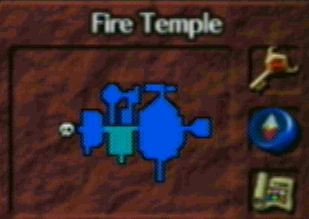
A map of the first floor. The first hub room is that egg-shaped room towards the east.
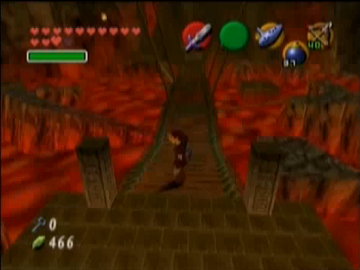
The first hub room.
The first hub room is just east of the opening room. On the map, itís the large egg-shaped room towards the east. Itís a great deal larger than its satellite rooms, suggesting that it is more complex than its satellite rooms. It is indeed; the room contains a series of platforms suspended over a pit of lava. In order to progress to any of the roomís exits, the player must navigate its platforms and face the constant threat of falling into lava. The process of crossing these gaps, leaping from platform to platform, calls the playerís focus.
For this hub room, there are three satellites. Two of these satellite rooms each contain a chest with a key, a goron, and nothing else: very clearly simplistic rooms. These two rooms have only one door; you enter from the hub room, grab the key, then go back to the hub room.
The third satellite room contains a skulltula guarded by a like-like and tiles that rise from the floor and fly at Link. This room does challenge the player, but it is also hidden behind a Song of Time block and is optional. For these two reasons, I think it's safe to consider this satellite room an aberration from the norm.
The hub room also leads outward to a path room. This path contains two puzzles and provides linear progress forward to the second hub room.
So, the first hub room provides a network of platforms over lava as a challenge to focus the player. Its satellite rooms are either simple or hidden, providing a break in the action. Once the player has cleared out all satellite rooms associated with this hub, he or she faces a puzzle in a path room on the path to the next hub room.
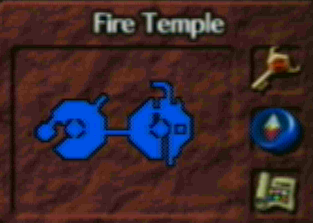
A map of the third floor.
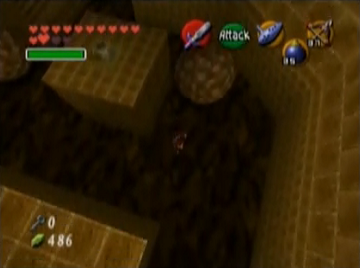
The second hub room.
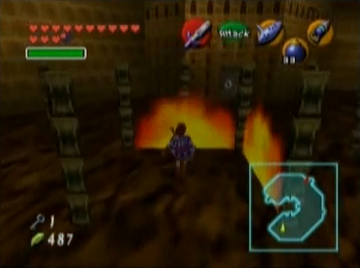
The fourth hub room. The second, third, and fourth hub rooms are on the third floor.
There are three hubs on the third floor. The first one you encounter is the room towards the east; look at the circle on the right, and it's the right half of that circle. You appear in that room after exiting the path up from the first floor. This room puts Link in a maze where he must avoid rolling boulders. The player must pay close attention to navigate the maze while avoiding the boulders; this lends the room its complexity. In addition, the player returns to this room to walk along the top of the maze, adding another level of intricacy.
This room also links (ha) to the left semicircle in two places, and the left semicircle itself has three doors. For this reason, it should be considered a hub room. It commands the player's focus by chasing the player with a moving fire barrier.
The third hub is the large western room on the third floor. Again, itís a large room, and it has multiple outward paths. The strength of this room lies in another maze; this time, the borders of the maze only appear as Link draws near them. In addition, these borders are made of damaging fire.
Here, you have a network of three hub rooms, each with multiple exits and each with a unique challenge.
Admittedly, the opening room of the Fire Temple breaks this formula. It acts as a hub room, leading you to many other rooms, but its own design is simplistic, since there are no obstacles in your traversal of this room. Rather, it leads to complex rooms. Also, there is a path room on this room's north side which loops back into this room rather than leading to another hub like the other path rooms in the dungeon. It may be worth noting that this path room is only accessible near the end of the playerís visit to the Fire Temple; here, one gets the boss key, the last thing necessary in this dungeon before facing the boss. The tone of this dungeon, then, changes only at its end. Is this a purposeful move? Why would would someone make that call? Itís a question to consider.
In the Fire Temple, hub rooms often lead out to two types of rooms: small satellite rooms with the single purpose of giving Link a key and path rooms that segue between challenges.
Path rooms involve simple puzzles, such as setting off one switch from a distance using a bomb. While these rooms do have substance, they donít demand as much time from the player as the hub rooms. These rooms have one challenge for Link, as opposed to hub rooms, which challenge him on multiple occasions in multiple places. Accessing each exit from a hub room is a challenge slightly different from all other challenges in that hub room. For instance, Link must return to each maze multiple times in order to explore its multiple paths and find each possible exit. Each time, he will have to cover a new portion of the maze.
It's also worth considering the room containing the hammer. It places one obstacle in Linkís path. Here, he must hit a switch, which activates a timer. Then he must reach the top of a twisting staircase before that timer runs out in order to obtain the hammer. Once this obstacle is cleared, the player may access a new exit from this room.
These non-hub rooms either offer one or zero obstacles, while Link must face the obstacles of hub rooms again and again.
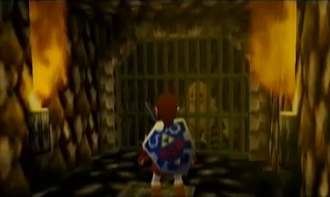
A common satellite room in the Fire Temple. These rooms do not grab the playerís attention; the player collects a key and quickly leaves.
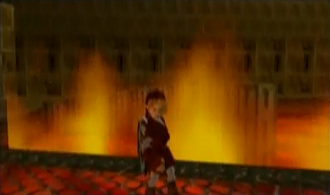
The fire-chasing room blurs the line between path room and hub room. It has one challenge, like a path room. However, it is ultimately a hub room because this challenge must be approached from multiple directions. Additionally, this room offers more than two doors.
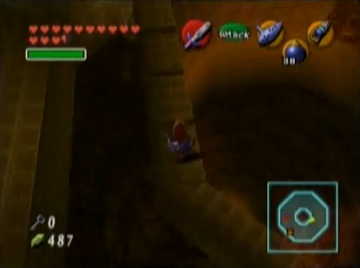
Link finds the hammer in this room. It gives him one challenge
The challenges of this dungeon rarely center around an item Link owns. That isnít to say they never do, though; for instance, some path rooms require Link to set off a switch with a bomb. However, most of the rooms--and more importantly, every hub room--has a challenge which does not require the use of an item. The four hub rooms are largely crossed by walking alone (you'll have to allow one use of bombs in the rolling boulder maze).
In part, this makes sense due to the dungeonís place in the gameís sequence. Link received weapons he used to a great extent in the Forest Temple, but since then, he has only received the Fire Tunic, which allows him to withstand high temperatures. That doesnít change gameplay at all, as it merely prevents Link from dying in hot rooms; it does nothing more. Also, the item of this dungeon is the hammer, which is only used in this dungeon to hit certain switches. However, hitting switches is hardly a new element of gameplay.
This approach also makes sense given the structure of the dungeon. If the hub rooms required Link to use items, these would be considered puzzles. If the player needed to solve a hub room's puzzles upon every visit, this would be tedious and repetitive. Alternatively, if the puzzles only needed to be solved once, the hub room would become bland after the first traversal, since the player would constantly reenter a room that has already been solved. Instead, hub rooms challenge the player with enemies and other damaging elements; these may be a constant threat to the player without becoming tiresome. This approach engages the player each time he or she enters a hub room without annoying him or her with repetitive puzzles.
Because of the Fire Temple's focus on hub rooms, the player often revisits old rooms. That leads to rooms which lend themselves to combat and mazes moreso than item-based puzzles.
The Forest Temple emphasizes path rooms, which means that the player encounters a series of new challenges in traversing the dungeon. (I will discuss this in a future post.) The Fire Temple emphasizes hub rooms which the player must revisit. Because the emphasis lies in hub rooms, there are fewer challenges than in the Forest Temple, but those challenges are revisited. The Water Temple focuses on one hub room with a changing water elevation, and while there are plenty of challenges in paths leading out from that hub, all of those paths are contingent on the state of water in that central hub, meaning there is one central challenge around which all others focus. The progression is from many discrete challenges (Forest Temple) to one one dungeon-wide challenge (Water Temple). The Fire Temple sits in the middle because it revisits challenges more often than the Forest Temple but does not linger on one challenge for the entire dungeon like the Water Temple.
To reiterate, this is the criteria I mean to establish for investigating a dungeon's construction: 1.) What are its hub rooms like? 2.) What are its dead-end satellite rooms like? 3.) What are its path rooms like? 4.) What are the gimmicks and puzzles used within the dungeon?
comments powered by Disqus
All original content on VG Thought was written by Greg Livingston AKA Golem.